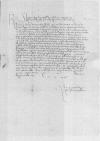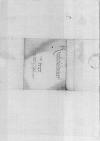Quae scribit ad nos Paternitas Vestra de serenissimo Daniae rege, ea iam ante ex illustris domini ⌊Prussiae ducis⌋, nepotis nostri carissimi, et ex ⌊Gedanensium⌋ litteris acceperamus. Itaque semota omni cunctatione misimus oratorem nostrum ad serenissimum ⌊Romanorum regem⌋ atque eum hortati sumus, ut ad bella et dissidia inter christianos principes tollenda animum adiceret atque de placandis et tranquillandis eorum animis curam et cogitationem una cum serenissimo ⌊fratre⌋ suo susciperet.
Nominatim autem quibus de rebus scribit ad nos Paternitas Vestra, eas ibidem recenseri iussimus. Ad ⌊imperatoriam vero maiestatem⌋ legatum nullum misimus, sed litteras accurate scribi fecimus, quibus ab illa magnopere contendimus, ut aut pacem inter istos dissidentes principes conciliaret, aut saltem indutias prorogaret. Responsum ab illa exspectamus. Quod si opus esse intellexerimus, fortasse et nuntium mittemus, modo prius, quid litteris nostris profectum sit, intelligamus.
⌊Comitiorum⌋ dies probatur nobis, qui est a Paternitate Vestra perscriptus, sed et locus placet ita tamen, ut antea quoque scribere nos meminimus Paternitati Vestrae, ut nihil necesse sit ad nos referre de mutando loco, si ita res postulabit. Id enim arbitrio Paternitatis Vestrae permittimus, quae una cum aliis ⌊terrae istius nostrae consiliariis⌋, quod erit visum commodius de loco statuat, licebit.
De ⌊Zelislawski⌋ semel atque iterum ⌊Gedanensibus⌋ respondimus et satisfactum illis esse per nos arbitramur.
Bene valeat Paternitas vestra.


 AGAD, AZ, 2999, f. 176v
AGAD, AZ, 2999, f. 176v